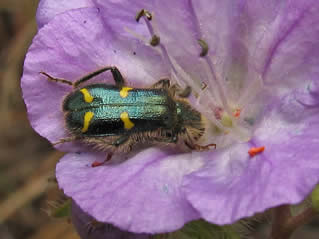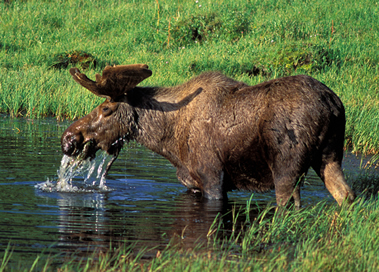

ZOOGEOGRAPHY OF BRITISH COLUMBIA

Ornate Checkered Beetle (Trichodes ornatus),
photo by Werner Eigelsreiter ©
by
Why are there more marsupials in South America than North America? Why are there Alligators, paddlefish and giant cryptobranchid salamanders in eastern Asia and eastern North America and nowhere in between? How does the number of species of dragonflies change with latitude, or with elevation? What is the breeding range of the White-headed Woodpecker?
These are examples of questions that are investigated in the field of zoogeography. Simply put, zoogeography is the study of the distribution of animal species on the surface of the earth. It complements and may involve other fields, such as phylogenetic systematics, paleontology, ecology, climatology and geology.
Zoogeography of British Columbia
The distributions of non-human animal species in British Columbia have been influenced by the position of the province relative to oceans and other land masses, the glaciations of the Pleistocene Epoch , mountainous topography, post-Pleistocene glacial climatic change, and interactions with humans.
Glaciation
Only 10000 years ago most of British Columbia was covered by ice sheets, during the last glacial period of the Pleistocene Epoch. There were two main ice sheets: the Cordilleran, which covered most of the province and southern Alaska, including the Aleutian Islands, and the Laurentide, which extended from eastern Biritish Columbia across most of Canada. (MAP)
The retreat of the glaciers and accompanying warming of the climate allowed the expansion of the ranges of plants and animals from areas that were not ice-covered, known as refugia. How many refugia existed and their influence on recent distributions are issues now receiving considerable attention using molecularly-based phylogenetic studies (See Comparative Phylogeography of Northwestern North America: A Synthesis).
The extent to which species have moved into previously glaciated areas depends on their ecological tolerances and means of dispersal. Many species of bird, insect or bat can cross all but the highest mountains, allowing for rapid expansion of ranges. Terrestrial species would be subject to a wider range of physical barriers, thus would not be expaected to recolonize glaciated regions as rapidly. Ranges of species are not static, but continuously expand and decrease, either as minor short-term fluctuations or major changes in distribution. Great differences can be observed even within single human lifetimes. Extirpations and range reductions due to human disturbances provide depressingly common examples, however, significant natural range expansions also occur.
Distribution of native freshwater fishes reflects the history of changing watersheds as glaciation retreated. Initially vast areas would have been flooded allowing widespread dispersal that ended as water levels dropped and watersheds became isolated.

Striped Nudibranch (Armina californica), photo by Derek
Holzapfel.
Topography
Species spread, and continue to spread, as far as the climate, topography and community of other species (biota) permit successful reproduction and maintenance of populations.The tendancy of species to disperse, or rate of dispersal, depends on a myriad of life history traits, including number and requirements of life stages, motility and generational longevity. The mountainous terrain of British Columbia has limiting effects on dispersal, for high, snow-capped mountains are a formidable physical and ecological barrier to almost all species.
Most significantly, the Rocky Mountains have cut off the central and eastern fauna of the continent from the interior and coast of the province. The north-south orientation of mountain ranges has tended to produce north-south biogeoclimatic zones, and corresponding faunal distributions. Within mountainous areas, numerous biogeoclimatic zones occur within relatively small areas. Species distributions can be expected to be narrow, depending on their individual ecological requirements and the distribution of other species that fulfil those requirements. Requirements, and availability of prey, forage, etc., may change seasonally, resulting, on some scale, in different winter and summer ranges for some species. The ranges of species such as ruminants and mountain birds are seasonally delineated, with distinct and narrow winter feeding and summer breeding ranges.
Extreme topography can lead to increased faunal diversity through isolation of populations, and subsequent speciation. Lowland populations of species are separated from each other by impassable land forms, or conversely, species adapted to high elevations will inevitably produce reproductively isolated populations that could result in speciation.
Recent Climate
The recent climate, and climate changes within the past 8,000 years, have left zoological footprints on the province. The combination of a cool wet coast adjacent to the mountains, and a predominantly east-moving weather pattern, causes loss of moisture as cooling air masses cross the coastal ranges, resulting in a rainshadow. The dry continental climate, "pocket desert" in the interior receives less than ??mm of precipitation annually. Several millenia ago, the province was warmer than it is now, and many species, particularly cold-blooded vertebrates, occur now at the northern extremes of what once were probably much more extensive ranges. Some of these species have become extirpated from the province in the past century.
Anthropogenic Effects - The Human Factor
The arrival of humans to this province has had a dramatic impact on faunal distributions. Animals of all sizes and groups have been used as human food, clothing and ornamentation, resulting in local extirpations. Since the arrival of Europeans and others in significant numbers since the early 1800s, the disruption of habitats, through clearing of forests, or conversion of wetlands to agricultural areas, has removed valuable habitat for many species. Additional anthropogenic effects have been the introduction of foreign species, including livestock, pets, and perennial hitchhikers such as rats. The introduction of foreign plants has also damaged grassland, wetland and forest ecoystems. The advent of automobiles and far-reaching road systems has led to roadkill as a major source of mortality, and hazards presented by cities and airports make these places potentially lethal to many species.
Coastal Giant Salamander (Dicamptodon tenebrosus), photo by Michael Bromm.
Endangered Species and Peripheral Populations
The greatest dangers faced by wildlife in British Columbia stem from loss of habitat to agriculture, urban development, and logging (BC Environment, 2000). These practices have to a great degree been most extensive in areas just north of the U.S. border, where, coincidently many species reach the northern limits of their range. These areas, with land well-suited to agriculture and housing, and surrounded by mountains that are readily accessible for logging (in particular the Lower Mainland and the southern Okanagan Valley), contain the northern populations of many animal species--reptiles, amphibians, mammals and others. From the onset of European settlement (approximately 1827) to 1990, the forested land area of the Lower Mainland decreased from 71% to 54%, and much of the cover had become second growth rather than mature. Over the same time span, wetland coverage had decreased from 10% to 1% (Boyle et al., 1997).
Populations at the periphery of ranges of species have been considered important to conserve because presumably at the edges of ranges the most extreme environmental/ ecological pressures will be experienced, which--assumming enough genetic variability is present in the population to start with--will provide opportunity for natural selection to produce new genotypes and phenotypes, ultimately leading to speciation.
It has been argued that only peripheral species that are spatially removed from a larger continuous range of a species are of conservation value because the disjunction in range implies absence of gene flow with the rest of the species, as opposed to peripheral species whose status is determined by a political jurisdictional boundary, which does not hinder gene flow. There has been much discussion as to the value of focussing resources on conserving peripheral populations of species whose ranges extend far beyond political boundaries (Bunnell et al. 2004, and references cited therein).

American Moose (Alces alces), photo by Ian Gardiner.
References
BC Environment. 2000. Environmental trends in British Columbia 2000. British Columbia Ministry of Environment, Lands and Parks. Victoria, BC.
Bernatchez, L. and C. C. Wilson. 1998. Comparative phylogeography of Nearctic and Paleartic fishes. Molecular Ecology 7: 431-452.
Boyle, C.A., L. Lavkulich, H. Schreier and E. Kiss. Changes in land cover and subsequent effects on Lower Fraser Basin Ecosystems from 1827 to 1990. Environmental Management 21: 185-196.
Bronosky, C.W., P.M. Anderson and P.J. Bartlein. 1987. The northwestern U.S. during deglaciation; vegetational history and paleoclimatic implications. In: The Geology of North America. North America and Adjacent Oceans during the Last Deglaciation. (W.F. Ruddiman and H.E. Wright Jr., Eds) K-3: 289-321. Geological Society of America, Boulder CO.
Bunnell, F. L. R. W. Campbell and K, A, Spires. 2004. Conservation priorities for peripheral species: the example of British Columbia. Canadian Journal of Forest Research 34: 2240-2247.
Janzen, F., J.G. Krenz, T.S. Haselkorn, E.D. Brodie Jr. and E.D. Brodie III. 2002. Molecular phylogeography of Common Garter Snakes (Thamnophis sirtalis) in western North America: implications for regional historical forces. Molecular Ecology 11: 1739-1751.
Josenhans, H.W., D.W. Fedje, K.W. Conway and J.V. Barrie. 1995. Postglacial sealevels on the western Canadian continental shelf: evidence for rapid change, extensive subaerial exposure and early human habitation. Marine Geolology 125: 73-94.
Runck, A. M.and J. A. Cook. 2005. Postglacial expansion of the southern red-backed vole (Clethrionomys gapperi) in North America. Molecular Ecology 14: 1445-1456. Waltari, E. J.R. Demboski, D. R. Klein and J. A. Cook. 2004. A molecular perspective on the historical biogeography of the northern high latitudes. Journal of Mammalogy 85: 591-600.
Additional References
Lesica, P., and McCune, B. Decline of arctic-alpine plants at the southern margin of their range following a decade of climatic warming. Journal: Journal of Vegetation Science 15(5) Pages: 679-690.
Scott, J. Michael, M. Murray, R.G. Wright, B. Csuti1, P. Morgan and R.L. Pressey. 2001. Representation of natural vegetation in protected areas: capturing the geographic range. Biodiversity and Conservation 10 (8): 1297 - 1301.
Links
Comparative Phylogeography of Northwestern North America: A Synthesis
Please cite these pages as:
Author, date, page title. In: Klinkenberg, Brian. (Editor) 2021. E-Fauna BC: Electronic Atlas of the Fauna of British Columbia [www.efauna.bc.ca]. Lab for Advanced Spatial Analysis, Department of Geography, University of British Columbia, Vancouver. [Date Accessed]
© Copyright 2021 E-Fauna BC.